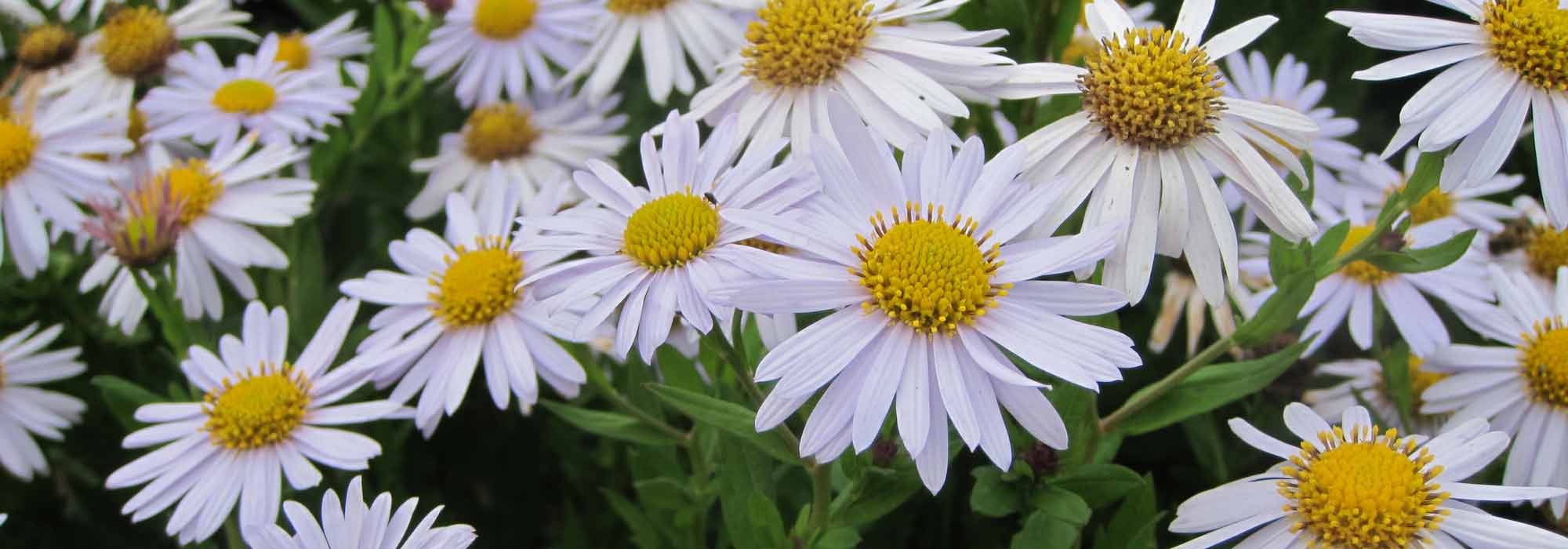
Kalimeris: planting, growing and care
Contents
Kalimeris in a nutshell
- Kalimeris is a very floriferous perennial, quite similar to asters, offering one of the longest flowerings in the garden
- Its flowers, resembling small white, blue, or lilac daisies, bloom all summer long until autumn, without interruption
- It is a very easy plant to grow, capable of thriving in many situations, very hardy and never sick
- Very tolerant, Kalimeris adapts to all types of soil and only requires sunshine!
- It is a perennial with a rustic appearance, perfect for summer borders, meadow gardens, and mixed-borders
A word from our expert
What would our summer and autumn gardens be without these pretty little white, blue, or lilac daisies? Kalimeris is a lovely perennial with aster flowers that is still unjustly overlooked. It has a significant advantage over its little cousin the aster; a much longer flowering period, great hardiness, and extraordinary adaptability.
Whether it’s Kalimeris incisa with its numerous cultivars, Kalimeris incisa ‘Madiva’, ‘Alba’, ‘Blue Star’, ‘Nana Blue’, or Kalimeris pinnatifada Hortensis with its countless double flowers, they offer a flurry of little stars from June to September, sometimes even until October, without interruption.
The flowering of Kalimeris is of an incomparable freshness in summer. Its sunny flowers are classics of sunny naturalist gardens and mixed borders, to which they bring much finesse and charm.
Very hardy (it easily withstands temperatures below -15°C), easy to grow, never sick, nothing affects its well-erected silhouette, not even wind, rain, or drought. It is a plant of extreme vigour that can only thrive in the garden!
It will show its gratitude as long as it is planted in ordinary to fertile, cool, and well-drained soil, in full sun or partial shade.
Discover Kalimeris, this little-known summer perennial that is so easy to live with, and create fresh and long-flowering scenes!
Description and Botany
Botanical data
- Latin name Kalimeris
- Family Asteraceae
- Common name Kalimeris
- Flowering From June to October
- Height 0.40 to 1.20 m
- Exposure Sun, partial shade
- Soil type All, well-drained
- Hardiness below -15°C
The Kalimeris, sometimes referred to as “Japanese Aster” or “Summer Aster,” is a herbaceous perennial related to Asters and daisies, belonging to the Asteraceae family, native to the woods and meadows of East Asia.
There are about ten rather outdated species, the most common in our gardens being Kalimeris incisa, which has given rise to interesting cultivars such as ‘Blue Star’, ‘Charlotte’, ‘Madiva’, and ‘Nana Blue’. Others, less well-known, like Kalimeris pinnatifida, Kalimeris mongolica, and Kalimeris yomena with ivory variegated foliage, are also occasionally offered for cultivation.
Fast-growing, Kalimeris is a running rhizomatous plant that gradually spreads over 1 to 2 meters in about ten years, eventually forming beautiful flowering colonies.
It grows in a bushy upright clump, rounded and produces new stems each year that branch out. While the habit is compact, dense, and always neat, the highly branched stems give the plant a light and airy appearance.
In this aster family, the height varies according to species and varieties. It reaches a minimum of 40 cm tall, but under good conditions, it can grow up to 1.20 m: Kalimeris incisa ‘Madiva’ is one of the tallest Kalimeris. It is a long-lived perennial that, once established, can live for many years. Some forms of Kalimeris self-seed spontaneously.
From this rhizomatous stump, rigid stems emerge in spring, starting in March, from a rosette of basal leaves. These erect and branched stems in their upper part bear numerous alternate leaves, oblong to round, sometimes very fine and dissected in Kalimeris pinnatifida, slightly to deeply indented.

Several colours of flowers: Kalimeris incisa ‘Nano Blue’, Kalimeris mongolica ‘Antonia’, Kalimeris pinnatifida ‘Hortensis’, Kalimeris incisa ‘Madiva’.
They can be glabrous or rough to the touch. Ranging from 3 to 15 cm long, they are smaller and more dissected in the lower part of the stems and entire in the upper part. Light green to deep green, they are dark green variegated with chartreuse and cream in Kalimeris yomena.
Deciduous, this fresh and vigorous foliage, typical of the aster family, resembles that of its close relatives, the daisies, Heleniums, and Echinaceas. The leaves emit a slight lemony scent when crushed.
These large leafy stems form a mossy, dentate, and verdant cushion from which a constellation of small flowers emerges from late spring. The summer flowering of Kalimeris is of incomparable freshness.
More so than its little cousin the Aster, Kalimeris offers one of the longest flowering periods, starting in May or June and lasting until the first frosts. Similar to those of Asters, the inflorescences in heads measuring 2 to 4 cm in diameter resemble the shape of daisies. They are grouped in corymbs. The large golden-yellow centre of this small bushy pompom is surrounded by a row of fine, long florets, arranged in one or two rows; Kalimeris pinnatifida var. hortensis bears very double flowers.
White with subtly violet reflections, pale lavender blue, soft blue, lilac blue, or entirely white, these ligules take on shades imbued with unique luminosity and freshness.
This remarkably generous and melliferous flowering lasts all summer, from 6 to 10 weeks: the flowers renew continuously, irresistibly attracting pollinating insects throughout the 5 months of flowering.
They make excellent wildflower bouquet flowers that will last about ten days in a vase.
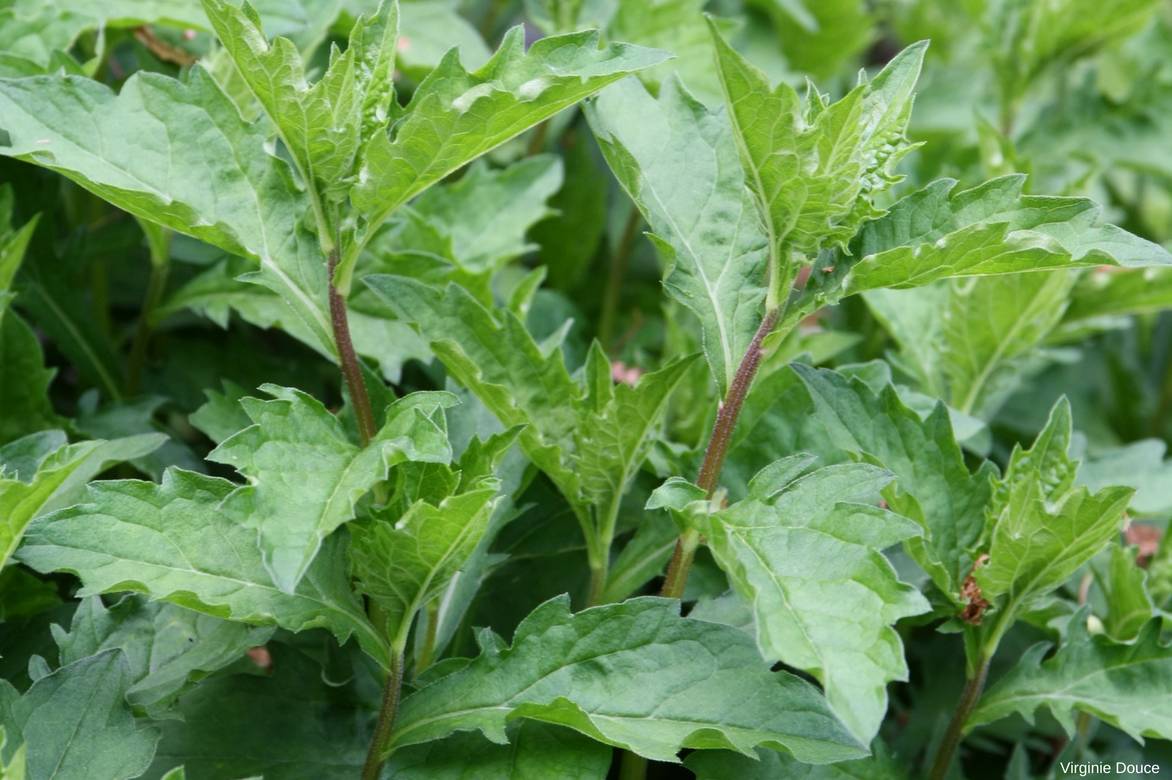
Foliage of Kalimeris incisa.
If you haven’t cut back the stems after flowering, the dried heads hanging from their flexible stems will extend into the dreary season; their seeds left in place will be a feast for some birds all winter.
Kalimeris is a very hardy plant, at least down to -20°C, that can be grown from the North to the South of France. Very tolerant, it thrives everywhere, in all soils, in all exposures and under all climates. Never sick, robust, once well established, it fears neither wind, nor rain, nor scorching sun, nor occasional drought.
It flowers sunny naturalistic beds, brightens dry slopes, and mixed borders. It is a perfect plant for gardens without gardeners, where it can be combined with other easy-going plants like Heleniums, asters, yarrow, hardy geraniums, or bellflowers.
Main species and varieties
The genus Kalimeris includes about ten species, the most commonly cultivated in our gardens being Kalimeris incisa, from which numerous cultivars such as ‘Madiva’, the tallest of the Kalimeris with large white flowers washed with blue, ‘Alba’, ‘Blue Star’, and ‘Nana Blue’, a small Kalimeris that does not exceed 40 cm, perfect for borders or pot cultivation, are derived.
In this still too little-known and unjustly underrepresented in gardens perennial, colours and heights are gradually multiplying in variations of blue and mauve, and new cultivars just as vigorous as the type are making their appearance.
You can also sometimes find, among passionate nurserymen, more obscure species such as Kalimeris pinnatifada and its cultivar ‘hortensis’ with very double flowers, Kalimeris mongolica, and Kalimeris yomena with strongly variegated ivory foliage.
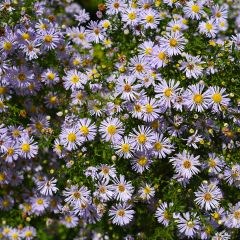
Kalimeris incisa
- Flowering time August to October
- Height at maturity 80 cm
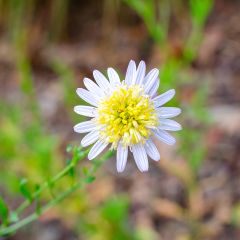
Kalimeris pinnatifida Hortensis
- Flowering time July to October
- Height at maturity 60 cm
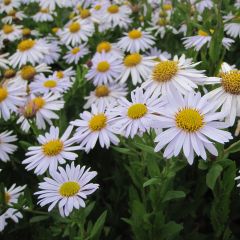
Kalimeris incisa Madiva
- Flowering time August to October
- Height at maturity 80 cm
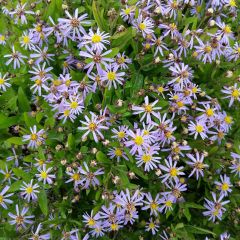
Kalimeris incisa Nana Blue
- Flowering time July to October
- Height at maturity 40 cm
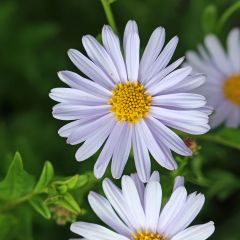
Kalimeris incisa Blue Star
- Flowering time July to October
- Height at maturity 60 cm
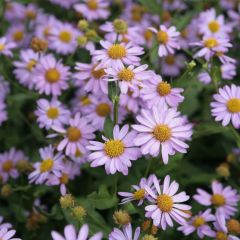
Kalimeris mongolica Antonia
- Flowering time August to December
- Height at maturity 80 cm
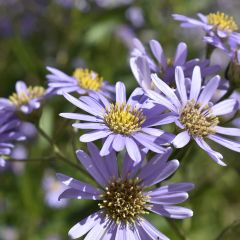
Kalimeris yomena Shogun
- Flowering time July to October
- Height at maturity 60 cm
Discover other Kalimeris
View all →Available in 0 sizes
Available in 2 sizes
Available in 1 sizes
Available in 3 sizes
Available in 1 sizes
Available in 1 sizes
Available in 1 sizes
Available in 2 sizes
Available in 2 sizes
Available in 1 sizes
Young plantation
Where to Plant Kalimeris?
Very easy to grow, with excellent hardiness (down to -15°C), Kalimeris grows everywhere in France. Robust, never sick, and with no particular requirements, it is extraordinarily adaptable. Once well-rooted, it thrives year after year, becoming increasingly floriferous. Give it space as its roots like to spread out comfortably.
It is a well-structured perennial; however, choose a spot preferably sheltered from the wind that could flatten the clumps, even though its upright stems usually stand without support.
It grows in any ordinary to rich, well-drained, and moderately moist soil. While it accepts all types of soil that are not too dry, it will reach its full potential in soil rich in organic matter that allows it to bloom well.
It enjoys a sunny exposure but also blooms well in light partial shade.
It prefers a well-drained soil that remains cool during summer, especially in the first few years. Once well established, Kalimeris will better tolerate occasional drought and intense heat.
Extraordinarily versatile, with its rustic appearance, it stands out in wild and low-maintenance gardens. It fits into all settings, flourishing as a middle plant, at the back of a border, or as a flower bed or pathway edging.
In the company of other easy-going perennials like itself, it creates natural-looking scenes, imbued with a great freshness. The taller Kalimeris (‘Madiva’), which tend to become slightly bare at the base, will be essential at the back of summer borders, adding much height and lightness.
Some varieties, of reasonable size (Kalimeris ‘Nana Blue’), are also suitable for container cultivation.
When to Plant Kalimeris?
Kalimeris can be planted almost all year round, except during frost and extreme heat, with a preference for spring from February to April or autumn from September to November.
How to Plant Kalimeris?
In the ground:
Plant in groups of 5 to 6 plants that will form airy clouds of blue or white stars, maintaining a distance of 30 cm between plants: it dislikes competition from roots.
- Prepare the soil well, removing roots of weeds and stones
- Make a hole three times the volume of the root ball
- Plant it in a mixture of potting soil, with a good amount of well-decomposed compost without burying the collar
- Mulch in spring to keep the soil cool during summer
- Water regularly after planting
- In spring, spread slug deterrent to protect young shoots
In a pot or container:
Choose a variety with a compact growth habit and a large pot of at least 30 cm in diameter and depth.
- Spread a good layer of drainage (gravel or clay balls) at the bottom of the pot
- Plant the root ball in a mixture of potting soil and compost
- Mulch and water very regularly, never allowing the substrate to dry out
Pruning and care
The Kalimeris truly requires little supervision. Once well-rooted in suitable soil, it needs no care or watering.
Robust and extraordinarily adaptable, it is hardly afraid of anything: neither diseases, nor bad weather, nor frost, nor strong winds, against which its stems do not bend, nor drought, nor the intense heat it can occasionally withstand.
In summer, water during the first year of planting and then only in case of prolonged drought thereafter.
Remove faded flowers to encourage the appearance of new ones throughout the summer: simply cut just below the flowers.
As soon as the new stems reach 30 to 40 cm, pinch them by removing the tip, to ramify the plant and increase flowering. This way, the clump will thicken, offer more resistance to bad weather, and may even do without unsightly staking!
At the end of the season, leave a few deflowered stems standing: very graphic, they will enliven the bed in winter.
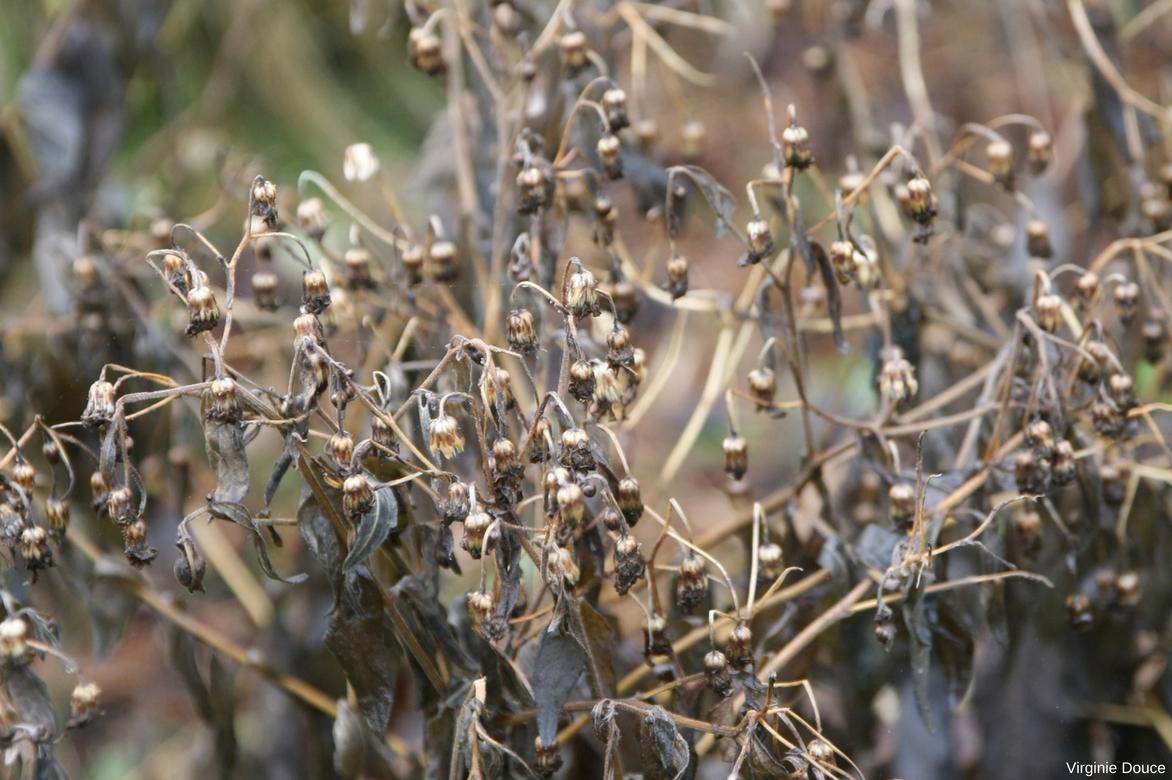
Faded stems of Kalimeris incisa.
In spring or autumn, cut back the remaining dried stems to ground level.
Mulch in May to ensure the base has sufficient moisture in summer. Add compost each year in autumn.
As the plant ages, it may show a more sparse flowering and signs of fatigue: Kalimeris should be replaced regularly. Every 3 to 4 years, in spring, before they decline, divide the largest stumps.
Multiplication : division, propagation by cuttings
The Kalimeris is easily propagated by division or by propagation by cuttings in spring.
Division
Dividing clumps should be done after 2 or 3 years, when the plant is well established. Divide in March-April.
- Using a spade, cut some clumps from the edge of the clump, ensuring each has at least one piece of vigorous rootstock or a leafy bud
- Immediately replant these fragments of rootstock in well-tilled, fresh soil or in pots
Propagating a Kalimeris
To propagate the Kalimeris:
- In spring, take stems about 10 cm long (take advantage of pinching to propagate!)
- Remove the lower leaves, leaving only the upper leaves
- Insert the cuttings halfway into pots filled with a mixture of 2/3 compost and 1/3 sand
- Place the cuttings in a humid environment without direct sunlight, in partial shade
- Keep the substrate slightly moist until rooting occurs
- Plant the young plants in the garden the following spring
Using and Combining Kalimeris in the Garden
The Kalimeris is the perennial best suited for long-lasting displays, bringing brightness, freshness, and a natural touch. Its abundant and prolonged flowering in harmonies of cool tones of white, blue, or mauve is essential in a naturalistic-inspired garden, cottage gardens, and contemporary meadows.
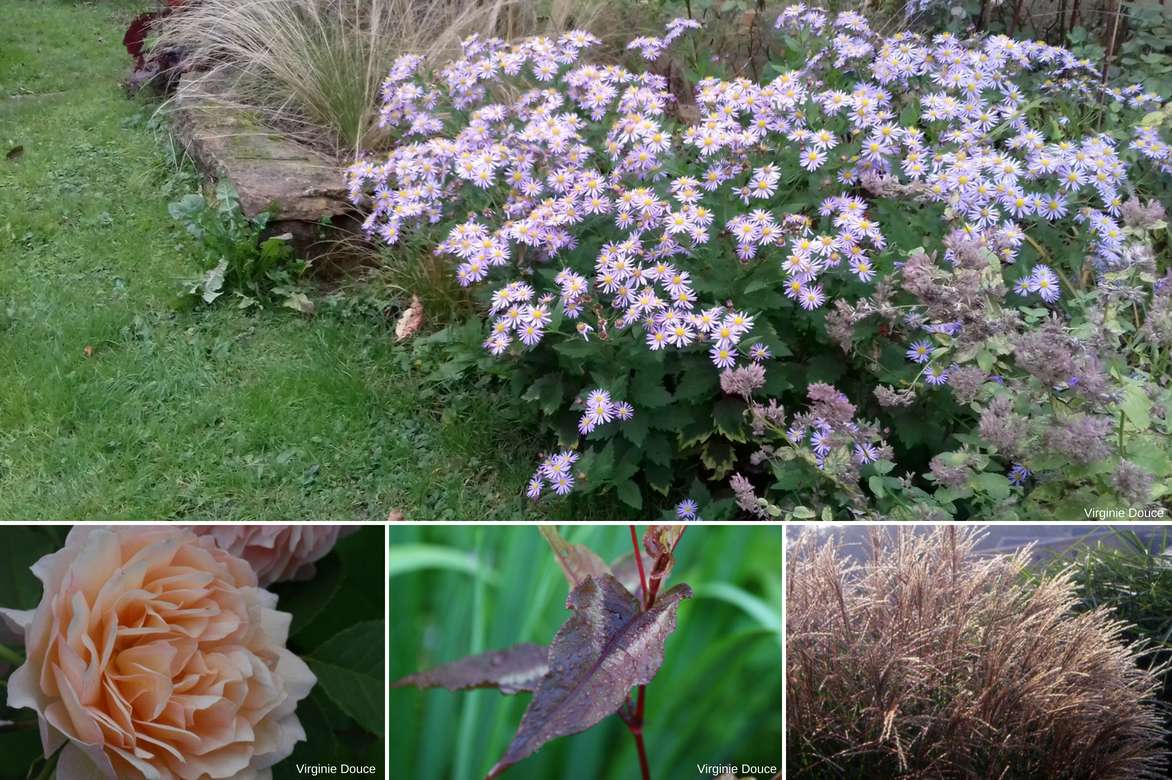
An example of a natural association: Kalimeris incisa, Rose ‘Grace’, Persicaria microcephala ‘Red Dragon’, Miscanthus sinensis ‘Kleine Fontäne’.
It is perfect for brightening mixed borders in the spirit of cottage gardens or for creating rustic-looking scenes, romantic and refreshing beds in the heart of summer with other perennials that, like it, require little care and maintenance. It is a perfect plant for gardens without gardeners!
The flowers harmonise with roses and purples and with almost all other colours, except perhaps lavender and mauve, which, in comparison, are too close and may appear dull.
Pair Kalimeris with Asters, and they will form fluffy clouds of small star-shaped flowers and extend the flowering in the garden until the end of summer and into autumn, as long as it does not freeze.
To flower a sunny corner with minimal effort, arrange around the Kalimeris an opulent mix of summer-flowering perennials that are robust and very hardy, growing on their own and becoming more opulent and floriferous each year; such as Daisies, Achilleas, Heleniums, white and purple Echinaceas, Knautia Arvensis – Field Scabious, Coreopsis, Echinops, or Phlox Paniculata Lilac Times, purple Salvias, Sedums, Garden Cornflowers, Sanguisorbas, and Eupatoriums.
The Kalimeris will accompany the autumn colours until the gates of winter with autumn chrysanthemums and Japanese anemones. For a striking effect that lasts only a few weeks, the intense red of a burning bush will highlight the finely starry flowers of a summer-flowering Kalimeris of a lovely blue like ‘Blue Star’.
In a more romantic composition, it will look lovely in a bed at the foot of old roses, a Buddleia, or Euphorbia characias. The small pale blue daisies will be charming next to the very fluffy grey-blue foliage of Stachys byzantina.
Placed at the edge of a bed, this large bushy and floriferous plant will highlight the slender silhouette and dress the bases of tall summer plants, such as Mallow, Lady’s Bedstraw, hollyhocks, Lupins, or Fireweed.

An idea for association: Epilobium angustifolium ‘Album’, Kalimeris incisa ‘Madiva’, Achillea millefolium ‘Salmon Beauty’, Gillenia trifoliata, Knautia macedonia.
To give a fresh touch to a summer border, plant the Kalimeris alongside a ground-cover rose (‘Larissa’), and hardy trailing geraniums with purple flowers.
In a beautiful naturalistic scene, grasses with feathery inflorescences such as Pennisetum, Calamagrostis x acutiflora ‘Karl Foerster’ with beautiful rose-bronze spikes, or Panicum virgatum ‘Warrior’ with red-brown foliage in autumn and fine brown-rose flowering in summer, along with light-statured perennials like Gaura or Gypsophila, will bring roundness, blur, and movement that the somewhat strict Kalimeris lacks.
Useful resources
- Discover all our Kalimeris varieties and choose from the summer flowering perennials to accompany them
- Advice sheet: 7 ideas for pairing Kalimeris
- Advice sheet: How to grow a Kalimeris in a pot?
- Subscribe!
- Contents
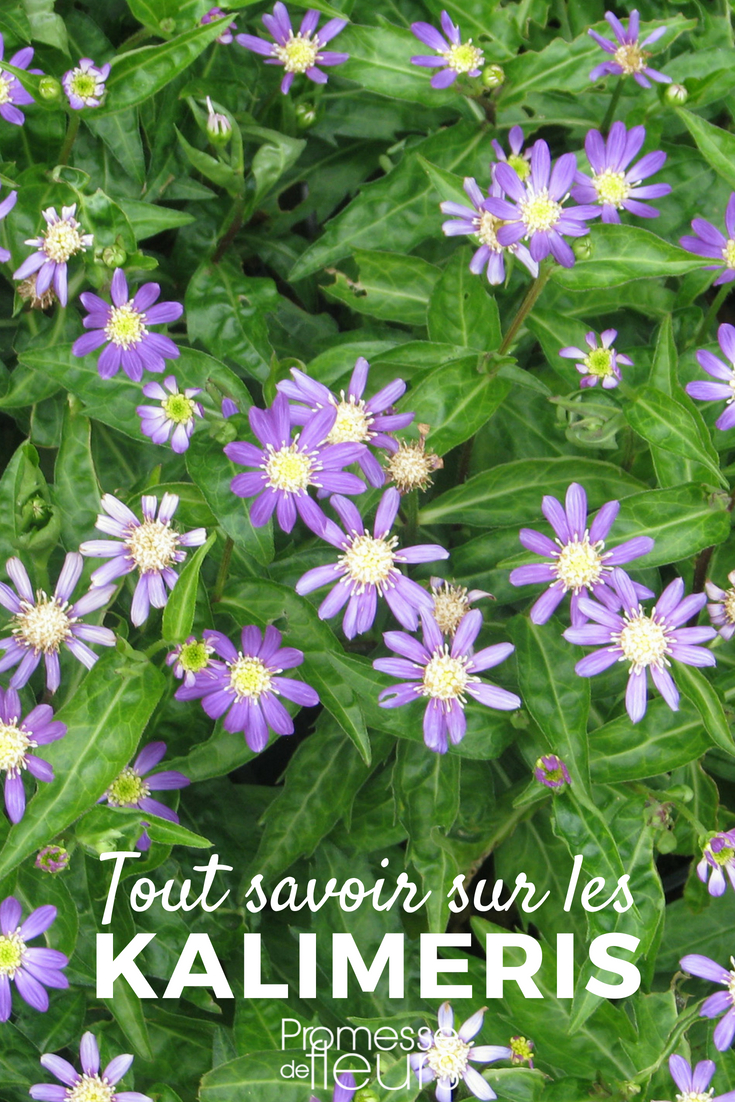
































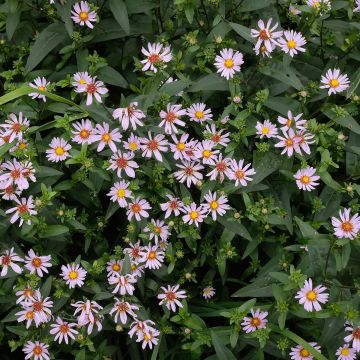


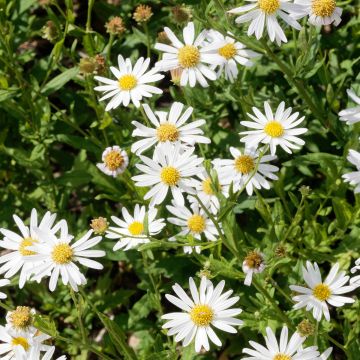





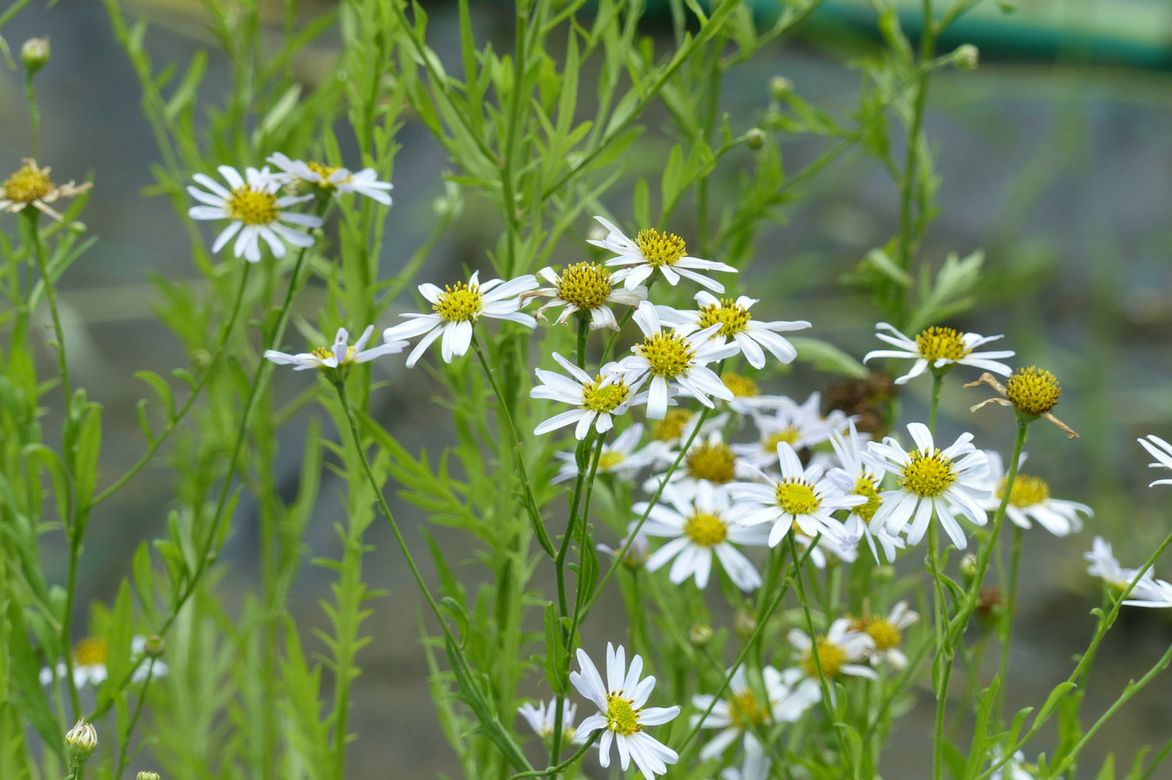
Comments